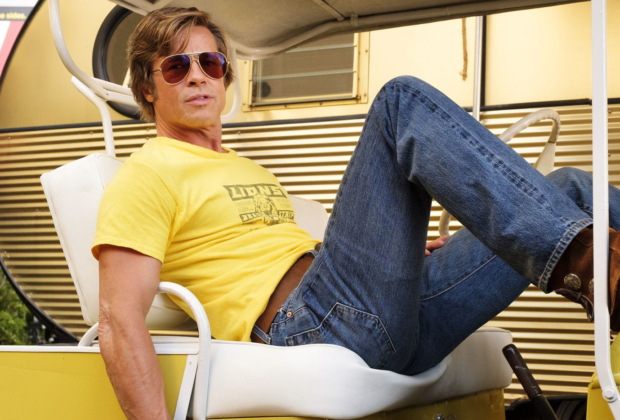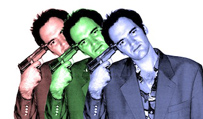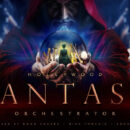SyncLove.com is a new channel from music discovery platform SyncFloor, which invites production professionals to dive into their favorite moments in films and share the scenes that changed the way they think about music for picture. With in-depth interviews, SyncLove offers good reads and intriguing insights about what works in sync, and how powerful the combination of music and picture can be.
--
The SyncLove guest contributor for this post is Jon Drawbaugh. Jon is an experienced advertising production executive with a history of producing high quality creative. He has production tours of duty at some of the top creative shops in the industry including Goodby, Silverstein and Partners, Mullen, Arnold, and R/GA. Currently Head of Production at Argonaut, Jon looks at his job as helping make creative dreams a reality. Putting production in the service of the creative idea, Jon pursues his goal of creating cultural moments for clients — aiming for the highest production value with an adaptable craft approach and always with an eye toward innovation.
Jon has chosen Once Upon a Time in Hollywood as the highlighted film and soundtrack for discussion. He points to the film’s skillful use of music to evoke a specific time and place (Los Angeles in 1969). Tarantino and music supervisor Mary Ramos turned to lesser known tracks by well-known artists, or unexpected covers of popular songs, that were in keeping with the history the film is based on, yet sound fresh in the context of the film. Digging deep is one great way, Jon explains, to find the right track.
Before we dive specifically into Once Upon a Time in Hollywood, tell us about the pairings of music and film that shaped you.
As I was trying to decide which movie to choose, I thought about when I started to pay attention to music in films. Music and film have always been hand in glove for me. As a teenager, the film-related music that first caught my ear was the Repo Man soundtrack, which I heard while watching on a crappy VHS tape in a friend’s basement, as well as Sid and Nancy, both Alex Cox films. Music was such an important part of those films, and it was the first time that I ever personally connected with the music on a soundtrack. It was my music, I felt, and it was great to see a film that was edgy and dark featuring great punk music.
I also got into connecting music to movement and drama via theater. I directed theater in college and for many years in NYC and San Francisco. Music was always a strong part of my creative process. I did deep music searches to make sure the music was unexpected and supportive of the narrative. I didn’t want to do things that were on the nose or obvious. When I was in college directing, I’d go through CDs or go to the library and try to find interesting or unusual tracks. In my early days of directing, I had to build my own music cues for a show on reel to reel using tape and a razor. Old school. I enjoyed putting myself in the music supervisor seat before I even knew that was a job. I was always really happy when I heard the audience commenting on the music selections. One of the last plays I directed in NYC, Tom Stoppard’s Rosencrantz and Guildenstern Are Dead, had a gutter punk theme that our sound designer had a field day with creating an amazing soundtrack using classic punk rock.
When I started in advertising, Microsoft had recently used The Rolling Stones’ “Start Me Up” to launch Windows 95 to much fanfare. The idea of using a commercially released music track in a TV spot was changing. Ad placement had lost its stigma. I later worked on a campaign for Philips Electronics where our music supervisor licensed the Beatles’ “Getting Better” and had a bunch of cool new bands cover the song, which worked really well by associating the brand with unexpected new musicians that I liked. I always loved digging through the stacks at a music store looking for a new underground or alternative band to be up on the latest music. Music defines your tribe and identity.
If you were to describe your identity in those days, what has that spirit?
I always loved all kinds of music. In high school, I was a bit of a neo-hippy alternative kid. I didn’t like to be put in a box or associated with a specific genre. I didn’t want to be stereotyped as a metalhead or punk or stoner. I played guitar poorly in bands with friends but also played trombone in the concert and marching band. In high school, I started out listening to classic rock and then got into alternative college radio music like the Violent Femmes and REM. The Pixies, Fugazi, and Jane’s Addiction were favorites of mine, too. I was in college when grunge hit. Like everyone I liked Nirvana, Pearl Jam, and Soundgarden. I was also into the Manchester sound, because I liked the way it harkened back to the 60s instrumentations. I always loved the Velvet Underground who are considered the forebears of alternative rock. A couple of us in high school “discovered” Coltrane and Miles. We liked the Beat Generation writers, so we fell into exploring jazz of that era. We thought we were so cool, because we were listening to jazz when everyone else listened to whatever was on MTV!
If you had to explain Once Upon a Time in Hollywood to someone in two minutes, how would you describe it?
It’s a film about the American Dream and Hollywood. It’s a celebration of a very specific time and place--LA in 1969--when society changed dramatically. Tarantino is showing America at the point in time when the positive idealism of the 60s gave way to darker destructive forces like cults, hard drugs, and violence. The Manson murders signaled the end of the idealism of the sixties. Joan Didion’s book The White Album explains this moment in history really well as the tenor of the nation changed after the assassinations of 1968. She wrote about feeling the change happening in Hollywood from the free spirit hippie vibe turning darker and more sinister especially as hard drugs took hold of the scene.
What I like is that it takes a horrible tragedy and turns it on it’s head into a fantasy. The real story is so brutal and awful. You think you know how it’s going to end. The whole movie you’re on this ride of tension and release. When you get to the finale, not to spoil the ending, there's relief when the horror starts but then takes a turn in a different direction than what really happened.
I think the other interesting thing about the film is it shows the caste system in Hollywood: crazy hippies in a cult out in the Valley, the washed up TV actor who was at the top of the heap but is in a downward spiral, and the new hot couple as Hollywood royalty. I loved how Tarantino tells that story. And going back to reality, Manson was a one of those desperate people trying to break into that world. There is a history of people moving to Hollywood to make their dreams come true, and it’s a boulevard of broken dreams. We see how all the characters get caught up in this striving for fame, and we see them at their most vulnerable. The fact that the historical event the film is based on was all instigated by a failed musician makes it obvious that music had to be a big part of this film. When you look at the layers of the tracks picked, it’s quite interesting.
Tarantino’s films always feature great music. When Reservoir Dogs came out, the music in the film got me to buy the soundtrack. Not just because it reminded me of the film, but because I loved the songs. Listening to the soundtrack was a way to appreciate artists I didn’t know, or artists you thought you knew but really heard for the first time. Mary Ramos, the music supervisor he uses on every film, is brilliant. They are really thoughtful about the cues they choose for his films.
Apparently, Tarantino has a record room in his house set up like a record shop, which sounds pretty dreamy. He’ll go through the racks and pick out tracks when he is working on a film. Mary will go through his LP selects and listen. Go back and dig some more. As any of us music nerds know, the digging through the stacks to find a hidden treasure is the biggest part of the allure. She apparently had to pick up fresher pressings of some of the albums because the ones in Quentin’s personal collection were so worn. For Once Upon a Time, he didn’t want any tracks after the events in the film. All the songs were released in 1969 or earlier.
Tell us about a scene in the film where the use of music truly moved you
There are so many great moments. Tarantino is a true music nerd who digs deep and was very deliberate in the tracks he chose for each scene.
One of my favorite sequences starts with Roman and Sharon leaving their home as Deep Purple’s “Hush” plays. The freedom and unbridled optimism you feel when driving around the Hollywood Hills is such a quintessential LA moment. I know I’ve felt that myself on a similar drive through the hills while a great track plays. When they arrive at their destination, THE Playboy Mansion, the The Buchanan Brothers’ “Son of a Lovin’ Man” sets the scene. It was a song I had heard before but never really paid attention to. There’s a carefree quality to it. At the mansion, there’s a party with famous actors like Steve McQueen (played by Damian Lewis), and rock stars with everyone smoking weed and having fun. It’s oddly wholesome. Margot Robbie as Sharon Tate dances through the crowd having the time of her life, then you learn the backstory and understand the depth of her and Roman’s relationship.
Another track and scene that stands out for me is Paul Revere & The Raiders’ “Hungry” when you meet Manson for the first and only time in the front yard of the Cielo Drive house. He asks to see record producer Terry Melcher, the owner of the house. I love that you only see Manson that one time, which is plenty. The use of that song is spot on. Paul Revere and The Raiders always seemed kind of cheesy on the surface, but if you listen to the songs, they’re really well written. It feels really appropriate, knowing that one of the band members lived with Terry on Cielo Dr.
Another great use of a song is “Out of Time” by the Rolling Stones. The song plays as some of the characters are winding down their day, Rick Dalton has returned to LA after a stint making Italian Westerns to start another chapter in his life, Cliff is spending his last day employed by Rick by going on a bender, a lonely pregnant Sharon Tate is hanging out with her house guests, and you realize this is THE day. The night the Manson murders happen. The story is coming to it’s finale and the song is ominously appropriate. Darkness is falling upon Hollywood.
The use of ads in the film was also really interesting. As an audience member, you initially just think the radio ads are simply sound design. You then realize they were as planned out as the music. My daughter pointed out that the second time when Cliff talks to Pussycat, you hear an ad for the fragrance named Heaven Sent over the radio, which I found really clever. “A little bit naughty, but heavenly in Heaven Sent”. It was a subtle hint of what Cliff thought about Pussycat. I love that the ads were included on the special edition double LP soundtrack.
The other idea behind the ads was to give the audience the full radio experience, something Tarantino also played with in Reservoir Dogs. Growing up in the 70s and 80s, the radio was always on in the background. It was part of your own personal soundtrack. You’d listen to the ads as much as the songs. In a way, it makes you appreciate the power of jingles. When I started out in the ad business, everyone was saying ‘We don’t want jingles anymore! We want cool songs.” But now you almost wonder if jingles are due for a come back.
If you could add music to the film’s soundtrack, what would you add?
There are songs that were directly connected to the Manson murders that weren’t included. Specifically no songs from The Beatles’ White Album nor any songs directly referencing LA or California. There are script references to The Doors and the song “California Dreaming” does play at one point, but it’s the José Feliciano version which was the more inspired choice over The Mamas and Papas. The film uses songs connected to the events, even if they aren’t associated with them in the popular imagination.
I thought they might use Manson’s song, “Never Cease to Exist”, that he sold to the Beach Boys and recorded as “Never Learn Not to Love”. Maybe that was too on the nose for Ramos and Tarantino.

Jon Drawbaugh, Head of Production, Argonaut.
What’s something fun you’re working on now?
We’re busy right now, which is great. We have a lot of exciting projects underway. A recent project for a fintech client was COVID-related. There was the supercut of every COVID commercial, and we didn’t want to fall in line. All the music on the spots were piano and minor chords. We went in the direction of an 8 bit keyboard track, which really cuts through while still maintaining the careful optimism of the message. Having the right piece of music was hugely important to us. We also shot a project for Fitbit before things went crazy, and we did the post-production under lockdown. Music played a big part in the overall tone and pacing of the spot. We are currently in remote production on several projects for Cricket, which we are very excited about. We are also embarking on a brand campaign for our new client, DropBox, who we won during the quarantine.
When you pair a great track with a great piece of creative, it’s amazing. The music can be stock, an original score from a music house, or a track a music supervisor pulled. I’ve worked with amazing supervisors in the past and have deep respect for their talent. When you have the budget to have a music supervisor and dig deep for tracks, it’s wonderful.
Artists are really open to working with brands. They want their music out there. We can give them a platform for their music as well being another revenue opportunity, and we can help build their following by exposing them to a larger audience. Hopefully, we can support musicians out there. We wouldn't have great ads without great musicians on licensed tracks or from a music house. We need to remember the craft and artisans behind the music.
Check out SyncLove.com for more!














